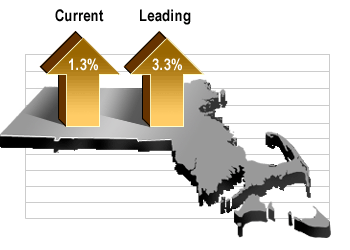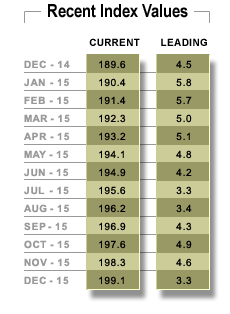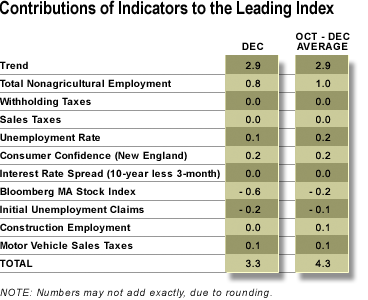Mass economy slows but continues to outpace the nation in Q4, UMass journal reports
Aging labor force, global economic sluggishness expected to slow pace of growth in 2016.
December 2015
 Massachusetts real gross domestic product grew at an annual rate of 1.3 percent in the fourth quarter of 2015 according to the MassBenchmarks Current Economic Index, released today by MassBenchmarks, the journal of the Massachusetts economy published by the UMass Donahue Institute in collaboration with the Federal Reserve Bank of Boston. In contrast, according to the U.S. Department of Commerce, national real gross domestic product grew at an annual rate of 0.7 percent during the same period.
Massachusetts real gross domestic product grew at an annual rate of 1.3 percent in the fourth quarter of 2015 according to the MassBenchmarks Current Economic Index, released today by MassBenchmarks, the journal of the Massachusetts economy published by the UMass Donahue Institute in collaboration with the Federal Reserve Bank of Boston. In contrast, according to the U.S. Department of Commerce, national real gross domestic product grew at an annual rate of 0.7 percent during the same period.
The Massachusetts Leading Economic Index for December is 3.3 percent, and the three-month average for October through December is 4.3 percent. The leading index is a forecast of the growth in the current index over the next six months, expressed at an annual rate. Thus, it indicates that the economy is expected to grow at an annualized rate of 3.3 percent over the next six months (through June 2016) if productivity were at long-term average rates.
The Massachusetts Leading Economic Index for December is 3.3 percent, and the three-month average for October through December is 4.3 percent. The leading index is a forecast of the growth in the current index over the next six months, expressed at an annual rate. Thus, it indicates that the economy is expected to grow at an annualized rate of 3.3 percent over the next six months (through June 2016) if productivity were at long-term average rates.
Recently revised data now reveal that in 2015 the state economy grew faster than the nation in all four quarters. MassBenchmarks now estimates that the Massachusetts economy expanded at annual rates of 3.1 percent in the first quarter, 5.7 percent in the second quarter, and 2.5 percent in the third quarter. The corresponding rates of growth for the nation according to the U.S. Bureau of Economic Analysis were 0.6 percent in the first quarter, 3.9 percent in the second quarter, and 2.1 percent in the third quarter.
 In the fourth quarter of 2015, the Massachusetts economy continued its expansion, but some key economic indicators are sending mixed signals. Job growth and spending were strong in the final three months of the year. But the unemployment rate rose a tenth of a point during the fourth quarter, even as it remained near pre-recession levels. However, wage and salary income appeared to decline in the fourth quarter following robust growth in the third quarter.
In the fourth quarter of 2015, the Massachusetts economy continued its expansion, but some key economic indicators are sending mixed signals. Job growth and spending were strong in the final three months of the year. But the unemployment rate rose a tenth of a point during the fourth quarter, even as it remained near pre-recession levels. However, wage and salary income appeared to decline in the fourth quarter following robust growth in the third quarter.
Payroll employment expanded at a 1.8 percent annual rate in the fourth quarter, following a 2.4 percent rate of growth in the third quarter. Nationally, job growth was also strong, growing at an annualized rate of 2.0 percent in the fourth quarter, up slightly from a 1.8 percent rate in the third quarter. For the year as a whole, between December 2014 and December 2015, the number of payroll jobs in Massachusetts increased by 2.1 percent while the number of jobs in the U.S. increased by 1.9 percent. While these jobs figures are subject to revision when the annual benchmark revisions are released in March, this represents the fastest job growth in Massachusetts since the end of the 1990's expansion in 2000.
The state's headline unemployment rate — the U-3 measure — was 4.7 percent in December, up slightly from 4.6 percent in September. During the same period, the U.S. unemployment rate declined modestly, falling from 5.1 percent in September to 5.0 percent in December. Both rates are close to pre-recession levels.
The broader U-6 measure of unemployment, however, which includes those who are working part-time but want full-time work, remains significantly above pre-recession levels. The Massachusetts U-6 unemployment rate in December was 9.8 percent while the U.S. rate in December was 9.9 percent. Prior to the recession, the Massachusetts rate was as low as 7.1 percent (in August and September 2007) while the U.S. rate reached its pre-recession nadir of 8.0 percent in March 2007.
"In the fourth quarter, Massachusetts wage and salary income declined at a 6.9 percent annual rate after expanding at a 7.5 percent rate in the third quarter," noted Alan Clayton-Matthews, MassBenchmarks Senior Contributing Editor and Associate Professor of Economics and Public Policy at Northeastern University, who compiles and analyzes the Current and Leading Indexes. "Part of this decline may be attributable to lower-than average bonus payments, as December is the beginning of the bonus season and stock market returns for the year were much lower than in recent years," Clayton-Matthews added. "Wage and salary income in the fourth quarter was 2.6 percent higher than in the fourth quarter of last year so it is clear that the trend remains positive," he concluded. Nationally, wage and salary income is on track to record an annualized growth of 4.9 percent in the fourth quarter, following growth of 5.4 percent in the second quarter.
Spending on items subject to the state regular sales tax and the motor vehicle sales tax both rebounded strongly in the fourth quarter, expanding at a 9.5 percent annualized rate after declining in the third quarter at a 3.2 percent rate. Year over year, this measure of spending indicates a 5.7 percent rate of growth between the fourth quarter of 2014 and the same period in 2015, reflecting both strong job growth and high consumer confidence. The latest MassInsight consumer confidence measure for Massachusetts was 121 in October, its highest level since October 2000.
The MassBenchmarks Leading Economic Index suggests that the state economy will continue to expand but will grow at a more restrained pace in the first half of 2016 than in the first half of 2015. The Leading Index is predicting a 2.4 percent annualized rate in the first quarter, and a 2.2 percent rate in the second. Three factors account for this expectation of a more moderate pace of growth. The first is the tightening labor market. As the number of unemployed workers continues to decline and as more baby boomers retire, it is becoming more difficult for employers to find the workers they need. This is reflected in historically low levels of initial unemployment claims, a sign that employers are reacting to the tightening labor market by holding on to the workers they have.
Another factor is expected slower global economic growth in 2016 as a result of slowing growth in China and continued sluggishness in the European economy. A third is recent financial turmoil in global markets in response to the weakness in the global economy and significant declines in commodity prices, especially oil prices. The Bloomberg stock market index for Massachusetts is down 12.7 percent year to date (through January 25th). Market volatility tends to dampen business confidence and investment. Therefore a prolonged market downturn, should it occur, can be expected to put downward pressure on consumer confidence and by extension consumer spending in coming months. Bonuses in the state's financial industry could also be negatively affected, which in turn could lead to lower than expected capital gains tax revenues, which the Commonwealth relies upon to close what has become its annual budget gap and to replenish its "rainy day fund."
 The 10 indicators that comprise the leading index usually do not all move in tandem. Typically, some may indicate an expectation of faster than average growth, while at the same time others may indicate an expectation of slower than average growth. The accompanying table accounts for the contributions of each towards faster or slower growth than the trend of 2.9 percent. The index value is their sum.
The 10 indicators that comprise the leading index usually do not all move in tandem. Typically, some may indicate an expectation of faster than average growth, while at the same time others may indicate an expectation of slower than average growth. The accompanying table accounts for the contributions of each towards faster or slower growth than the trend of 2.9 percent. The index value is their sum.
In December, four indicators contributed to a forecast of above-trend growth: total nonagricultural employment, the unemployment rate, consumer confidence, and motor vehicle sales taxes. Four indicators contributed to average-trend growth: withholding taxes, sales taxes, the interest rate spread between 10year and 3month U.S. Treasury securities, and construction employment. Two indicators contributed to below-trend growth: the Bloomberg stock index for Massachusetts, and initial unemployment claims.
In the three-month period October through December, five indicators contributed to a forecast of above-trend growth: total nonagricultural employment, the unemployment rate, consumer confidence, construction employment, and motor vehicle sales taxes. Three indicators contributed to average-trend growth: withholding taxes, sales taxes, and the interest rate spread between 10year and 3month U.S. Treasury securities. Two indicators contributed to below-trend growth: the Bloomberg stock index for Massachusetts, and initial unemployment claims.
The current and historical quarterly estimates for state domestic product growth include adjustments for changes in productivity growth. These adjustments are estimates of the quarterly deviations from the 1978-2014 trend in the growth of the ratio of output to employment and output to wage and salary income. In the fourth quarter of 2015 these adjustments subtracted 3.1 percentage points from the annual rate of growth. In the third quarter of 2015, these adjustments subtracted 2.0 percentage points from the annual rate of growth. In the second quarter, these adjustments subtracted 0.0 percentage points from the annual rate of growth. In the first quarter of 2015, these adjustments subtracted 2.3 percentage points from the annual rate of growth. For the forecast of state domestic product growth in the first and second quarters of this year, productivity growth is assumed to return to the average of the last five years.
Several recent months of the indices are revised in each release. These revisions are a result of the statistical method used to create the index, as well as revisions in the underlying indicators.
--------
All of the indicators except interest rates and consumer confidence refer to Massachusetts. The current index is composed of four indicators: nonagricultural employment, withholding taxes, sales taxes, and the unemployment rate. The leading index includes these four current indicators plus the other six (leading) indicators in the contributions table. All of the indicators are as of December 2015, except for interest rates and the Bloomberg stock index for Massachusetts, which are through January 20, 2016. The MassInsight Consumer Confidence Index is released every third month. Intervening months are interpolated, and changes in the Conference Board's Consumer Confidence Index for the U.S. are used to extrapolate to the current month of the index, as needed. Series measured in current dollars or values, i.e., withholding taxes, sales taxes, the Bloomberg stock index, and motor vehicle sales taxes, are deflated by the U.S. consumer price index for all urban consumers, excluding food and energy.
For a description of the methodology used to construct these indices, see: Alan Clayton-Matthews and James H. Stock, "An application of the Stock/Watson index methodology to the Massachusetts economy," Journal of Economic and Social Measurement, vol. 25 (1998/1999), pp. 183-233.
Dr. Alan Clayton-Matthews
MassBenchmarks
Northeastern University, School of Public Policy and Urban Affairs
January 29, 2016

